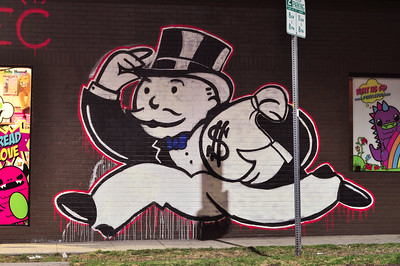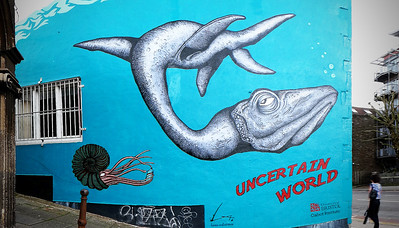Archive for the ‘How To’ Category
Three Scenarios for Scaling Up the Work
 Breaking up work into small chunks can be a good way to get things started. Because the scope of each chunk is small, the cost of each chunk is small making it easier to get approval to do the work. The chunk approach also reduces anxiety around the work because if nothing comes from the chunk, it’s not a big deal because the cost of the work is so low. It’s a good way to get started, and it’s a good way to do a series of small chunks that build on each other. But what happens when the chunks are successful and it’s time to scale up the investment by a factor of several hundred thousand or a million?
Breaking up work into small chunks can be a good way to get things started. Because the scope of each chunk is small, the cost of each chunk is small making it easier to get approval to do the work. The chunk approach also reduces anxiety around the work because if nothing comes from the chunk, it’s not a big deal because the cost of the work is so low. It’s a good way to get started, and it’s a good way to do a series of small chunks that build on each other. But what happens when the chunks are successful and it’s time to scale up the investment by a factor of several hundred thousand or a million?
The scaling scenario. When the early work (the chunks) was defined an agreement in principle was created that said the larger investment would be made in a timely way if the small chunks demonstrated the viability of a whole new offering for your customers. The result of this scenario is a large investment is allocated quickly, resources flow quickly, and the scaling work begins soon after the last chunk is finished. This is the least likely scenario.
The more chunks scenario. When the chunks were defined, everyone was excited that the novel work had actually started and there was no real thought about the resources required to scale it into something meaningful and material. Since the resources needed to scale were not budgeted, the only option to keep things going is to break up the work into another series of small chunks. Though the organization sees this as progress, it’s not. The only thing that can deliver the payout the organization needs is to scale up the work. The follow-on chunks distract the company and let it think there is progress, when, really, there is only delayed scaling.
The scale next year scenario. When the chunks were defined, no one thought about scaling so there was no money in the budget to scale. A plan and cost estimate are created for the scaling work and the package waits to be assessed as part of the annual planning process. And as the waiting happens, the people that did the early work (the chunks) move on to other projects and are not available to do the scaling work even if the work gets funded next year. And because the work is new it requires new infrastructure, new resources, new teams, new thinking, and maybe a new company. All this newness makes the price tag significant and it may require more than one annual planning cycle to justify the expense and start the work.
Scaling a new invention into a full-sized business is difficult and expensive, but if you’re looking to create radical growth, scaling is the easiest and least expensive way to go.
“100 Dollar Bills” by Philip Taylor PT is licensed under CC BY-SA 2.0.
How To Complete More Projects
 Before you decide which project to start, decide which project you’ll stop.
Before you decide which project to start, decide which project you’ll stop.
The best way to stop a project is to finish it. The next best way is to move the resources to a more important project.
If you find yourself starting before finishing, stop starting and start finishing.
People’s output is finite. Adding a project that violates their human capacity will not result in more completed projects but will cause your best people to leave.
If people’s calendars are full, the only way to start something new is to stop something old.
If you start more projects than you finish, you’re stopping projects before they’re finished. You’re probably not stopping them in an official way, rather, you’re letting them wither and die a slow death. But you’re definitely stopping them.
When you start more projects than you finish, the number of active projects increases. And without a corresponding increase in resources, fewer projects are completed.
The best way to reduce the number of projects you finish is to start new projects.
Make a list of the projects that you stopped over the last year. Is it a short list?
Make a list of projects that are understaffed and under-resourced yet still running in the background. Is that list longer?
A rule to live by: If a project is understaffed, staff it or stop it.
If you can’t do that, reduce the scope to fit the resources or stop it.
Would you prefer to complete one project at a time or do three simultaneously and complete none?
When it comes to stopping projects, it’s stopped or it isn’t. There’s no partial credit for talking about stopping a project.
If you want to learn if a project is worthy of more resources, stop the project. If the needed resources flow to the project, the project is worthy. If not, at least you stopped a project that shouldn’t have been started.
People don’t like working on projects where the work content is greater than the resources to do the work. These projects are a major source of burnout.
If you know you have too many projects, everyone else knows it too. Stop the weakest projects or your credibility will suffer.
“Circus Renz Berlin, Holland 2011” by dirkjanranzijn is licensed under CC BY-ND 2.0.
The best time to design cost out of our products is now.
 With inflation on the rise and sales on the decline, the time to reduce costs is now.
With inflation on the rise and sales on the decline, the time to reduce costs is now.
But before you can design out the cost you’ve got to know where it is. And the best way to do that is to create a Pareto chart that defines product cost for each subassembly, with the highest cost subassemblies on the left and the lowest cost on the right. Here’s a pro tip – Ignore the subassemblies on the right.
Use your costed Bill of Materials (BOMs) to create the Paretos. You’ll be told that the BOMs are wrong (and they are), but they are right enough to learn where the cost is.
For each of the highest-cost subassemblies, create a lower-level Pareto chat that sorts the cost of each piece-part from highest to lowest. The pro tip applies here, too – Ignore the parts on the right.
Because the design community designed in the cost, they are the ones who must design it out. And to help them prioritize the work, they should be the ones who create the Pareto charts from the BOMs. They won’t like this idea, but tell them they are the only ones who can secure the company’s future profits and buy them lots of pizza.
And when someone demands you reduce labor costs, don’t fall for it. Labor cost is about 5% of the product cost, so reducing it by half doesn’t get you much. Instead, make a Pareto chart of part count by subassembly. Focus the design effort on reducing the part count of subassemblies on the left. Pro tip – Ignore the subassemblies on the right. The labor time to assemble parts that you design out is zero, so when demand returns, you’ll be able to pump out more products without growing the footprint of the factory. But, more importantly, the cost of the parts you design out is also zero. Designing out the parts is the best way to reduce product costs.
Pro tip – Set a cost reduction goal of 35%. And when they complain, increase it to 40%.
In parallel to the design work to reduce part count and costs, design the test fixtures and test protocols you’ll use to make sure the new, lower-cost design outperforms the existing design. Certainly, with fewer parts, the new one will be more reliable. Pro tip – As soon as you can, test the existing design using the new protocols because the only way to know if the new one is better is to measure it against the test results of the old one.
And here’s the last pro tip – Start now.
Image credit — aisletwentytwo
The Power of Stopping
 If when you write your monthly report no one responds with a question of clarification or constructive comment, this may be a sign your organization places little value on your report and the work it stands for. If someone sends a thank you email and do not mention something specific in your report, this masked disinterest is a half-step above non-interest and is likely also a sign your organization places little value on your report and the work it stands for.
If when you write your monthly report no one responds with a question of clarification or constructive comment, this may be a sign your organization places little value on your report and the work it stands for. If someone sends a thank you email and do not mention something specific in your report, this masked disinterest is a half-step above non-interest and is likely also a sign your organization places little value on your report and the work it stands for.
If you want to know for sure what people think of your work, stop writing your report. If no one complains, your work is not valuable to the company. If one person complains, it’s likely still not valuable. And if that single complaint comes from your boss, your report/work is likely not broadly valuable, but you’ll have to keep writing the report.
But don’t blame the organization because they don’t value your work. Instead, ask yourself how your work must change so it’s broadly valuable. And if you can’t figure a way to make your work valuable, stop the work so you can start work that is.
If when you receive someone else’s monthly report and you don’t reply with a question of clarification or constructive comment, it’s because you don’t think their work is all that important. And if this is the case, tell them you want to stop receiving their report and ask them to stop sending them to you. Hopefully, this will start a discussion about why you want to stop hearing about their work which, hopefully, will lead to a discussion about how their work could be modified to make it more interesting and important. This dialog will go one of two ways – they will get angry and take you off the distribution list or they will think about your feedback and try to make their work more interesting and important. In the first case, you’ll receive one fewer report and in the other, there’s a chance their work will blossom into something magical. Either way, it’s a win.
While reports aren’t the work, they do stand for the work. And while reports are sometimes considered overhead, they do perform an inform function – to inform the company of the work that’s being worked. If the work is amazing, the reports will be amazing and you’ll get feedback that’s amazing. And if the work is spectacular, the reports will be spectacular and you’ll get feedback that matches.
But this post isn’t about work or reports, it’s about the power of stopping. When something stops, the stopping is undeniable and it forces a discussion about why the stopping started. With stopping, there can be no illusion that progress is being made because stopping is binary – it’s either stopped or it isn’t. And when everyone knows progress is stopped, everyone also knows the situation is about to get some much-needed attention from above, wanted or not.
Stopping makes a statement. Stopping gets attention. Stopping is serious business.
And here’s a little-known fact: Starting starts with stopping.
Image credit — joiseyshowaa
The Keepers of the Process
 If you want to improve the work, ask the people who do the work. They know the tools and templates. They know the ins and outs of the process. They know when and how to circumvent the process. And they know what will break if you try to change the process. And what breaks is the behavior of the people that use the process.
If you want to improve the work, ask the people who do the work. They know the tools and templates. They know the ins and outs of the process. They know when and how to circumvent the process. And they know what will break if you try to change the process. And what breaks is the behavior of the people that use the process.
When a process changes, people’s behavior does not. Once people learn the process, they want to continue to work that way. It’s like their bodies know what to do without even thinking about it. But on the other hand, when a process doesn’t meet the need, people naturally modify their behavior to address the shortcomings of the process. And in this case, people’s behavior doesn’t match the process yet they standardize their behavior on circumventing the process. Both of these realities – people like to do what they did last time and people modify their behavior to address shortcomings of the process – make it difficult for people to change their behavior when the process changes.
When the process doesn’t work but the modified behavior does, change the process to match the modified behavior. When that’s not possible, ask the people why they modified their behavior and ask them to come up with a process that is respectful of their on-the-fly improvements and respectful of the company’s minimum requirements for their processes.
When the process doesn’t work but the people are following it anyway, ask them to come up with ways to improve the process and listen to their ideas. Then, run a pilot of their new process on the smallest scale and see what happens. If it makes things better, adopt the process on a larger scale and standardize on the new way to work. If it makes things worse, stop the pilot and try another improvement suggested by the team, again on a small scale. Repeat this process until the process performs satisfactorily.
When the people responsible for doing the work are given the opportunity to change their processes for the better, there’s a good chance the broader population that uses the process will ultimately align their behavior to the new process. But the change will not be immediate and there may be some backsliding. But, because the keepers of the process feel ownership of the new process and benefit from the change, they will continue to reinforce the new behavior until it becomes new behavior. And if it turns out the new process needs to be modified further, the keepers of the process will make those changes and slowly align the behavior to match the process.
When the new process is better than the old one, people will ultimately follow the new process. And the best way to make the new process better than the old one is to ask the people who do the work.
Image credit — Old Photo Profile
How To Solve Transparent Problems
 One of the best problems to solve for your customers is the problem they don’t know they have. If you can pull it off, you will create an entirely new value proposition for them and enable them to do things they cannot do today. But the problem is they can’t ask you to solve it because they don’t know they have it.
One of the best problems to solve for your customers is the problem they don’t know they have. If you can pull it off, you will create an entirely new value proposition for them and enable them to do things they cannot do today. But the problem is they can’t ask you to solve it because they don’t know they have it.
To identify problems customs can’t see, you’ve got to watch them go about their business. You’ve got to watch all aspects of their work and understand what they do and why they do it that way. And it’s their why that helps you find the transparent problems. When they tell you their why, they tell you the things they think cannot change and the things they consider fundamental constraints. Their whys tell you what they think is unchangeable. And from their perspective, they’re right. These things are unchangeable because they don’t know what’s possible with new technologies.
Once you know their unchangeable constraints, choose one to work on and turn it into a tight problem statement. Then use your best tools and methods to solve it. Once solved, you’ve got to make a functional prototype and show them in person. Without going back to them with a demonstration of a functional prototype, they won’t believe you. Remember, you did something they didn’t think was possible and changed the unchangeable.
When demonstrating the prototype to the customer, just show it in action. Don’t describe it, just show them and let them ask questions. Listen to their questions so you can see the prototype through their eyes. And to avoid leading the witness, limit yourself to questions that help you understand why they see the prototype as they do. The way they see the prototype will be different than your expectations, and that difference is called learning. And if you find yourself disagreeing with them, you’re doing it wrong.
This first prototype won’t hit the mark exactly, but it will impress the customer and it will build trust with them. And because they watched the prototype in action, they will be able to tell you how to improve it. Or better yet, with their newfound understanding of what’s possible, they might be able to see a more meaningful transparent problem that, once solved, could revolutionize their industry.
Customers know their work and you know what’s possible. And prototypes are a great way to create the future together.
“Transparent” by Rene Mensen is licensed under CC BY 2.0.
What you do next is up to you.
 If you don’t know why you’re doing what you’re doing, you can try to remember why you started the whole thing or you can do something else. Either can remedy things, but how do you choose between them? If you’ve forgotten your “why”, maybe it’s worth forgetting or maybe something else temporarily came up that pushed your still-important why underground for a short time. If it’s worth forgetting, maybe it’s time for something else. And if it’s worth remembering, maybe it’s time to double down. Only you can choose.
If you don’t know why you’re doing what you’re doing, you can try to remember why you started the whole thing or you can do something else. Either can remedy things, but how do you choose between them? If you’ve forgotten your “why”, maybe it’s worth forgetting or maybe something else temporarily came up that pushed your still-important why underground for a short time. If it’s worth forgetting, maybe it’s time for something else. And if it’s worth remembering, maybe it’s time to double down. Only you can choose.
If you still remember why you’re doing what you’re doing, you can ask yourself if your why is still worth its salt or if something changed, either inside you or in your circumstances, that has twisted your why to something beyond salvage. If your why is still as salty as ever, maybe it’s right to stay the course. But if it’s still as salty as ever but you now think it’s distasteful, maybe it’s time for a change.
When you do what you did last time, are you more efficient or more dissatisfied, or both? And if you imagine yourself doing it again, do you look forward to more efficiency or predict more dissatisfaction? These questions can help you decide whether to keep things as they are or change them.
What have you learned over the last year? Whether your list is long or if it’s short, it’s a good barometer to inform your next chapter.
What new skills have you mastered over the last year? Is the list long or short? If you don’t want to grow your mastery, keep things as they are.
Do the people you work with inspire you or bring you down? Are you energized or depleted by them? If you’re into depletion, there’s no need to change anything.
Do you have more autonomy than last year? And how do you feel about that? Let your answers guide your future.
What is the purpose behind what you do? Is it aligned with your internal compass? These two questions can bring clarity.
You’re the only one who can ask yourself these questions; you’re the only one who can decide if you like the answers; and you’re the only one who is responsible for what you do next. What you do next is up to you.
“Fork in the road” by Kai Hendry is licensed under CC BY 2.0.
Triangulation of Leadership
Put together things that contradict yet make a wonderfully mismatched pair.
Say things that contradict common misunderstandings.
See the dark and dirty underside of things.
Be more patient with people.
Stomp on success.
Dissent.
Tell the truth even when it’s bad for your career.
See what wasn’t but should have been.
Violate first principles.
Protect people.
Trust.
See things as they aren’t.
See what’s missing.
See yourself.
See.
“man in park (triangulation)” by Josh (broma) is licensed under CC BY 2.0.
The Power of Praise
 Praise happens when you tell someone they did something wonderful. Praise is virtually free and almost the most powerful force in the universe.
Praise happens when you tell someone they did something wonderful. Praise is virtually free and almost the most powerful force in the universe.
When you tell someone what they did was amazing, they stand three inches taller. Right in front of you, they get taller. They grow. They expand. Don’t believe me? Try it. And bring a ruler.
To deliver praise, you must pay attention. You must invest in what’s going on, you must hear what is said, and watch what is done. Congratulations. Though you have yet to deliver praise, you’ve already differentiated yourself. Next, you must compare the behavior against the norms and recognize a difference. Sure, it’s a simple difference calculation, but it’s a calculation that takes attention and caring, which in today’s rat race are in short supply. Now, you must find words the right words to describe the specialness of the behavior-why it’s different and why it matters. Then, you’ve got to deliver it in a way that is worthy of the specialness.
Deliver praise in public and be specific. This person (use their name) did (say what they did) and it’s important because (and say why it is important). And tell people what you think and feel. They (use their name) did (say what they did) and I feel (e.g., happy, excited, proud) because (tell them why you feel as you do). Feel free to steal that script, but if you do, stick to it because it’s a good one.
A rule: If you don’t praise people, you don’t know what you’re doing.
But here’s the thing about praise. If you fake it, you bring about its opposite. When you fake it, people get smaller and they get angry. They get smaller because they know they are being patronized. And they get angry for the same reason. So, a word of caution. If you deliver paise that’s fake, you will lose all credibility with the recipient and anyone in earshot. And it’s such a violation of their dignity, I don’t know a way to resurrect their trust. In short, if you fake it, it’s over for you.
Another rule: If you have the urge to deliver fake praise, don’t.
Praise is powerful, but in today’s environment is almost extinct. It’s not that praise-worthy behavior is uncommon, rather, the time and attention required to recognize and formally acknowledge praise-worthy behavior is uncommon.
If you want to elevate the performance of a team, praise their behavior. And do it in public. Pay attention and praise. Schedule a meeting, buy the pizza, and praise. Be specific, be genuine, and praise.
Yes, you will spend a lot of money on pizza, and, yes, that is the best return on investment in the universe.
“Alex and his lion friend” by Tambako the Jaguar is marked with CC BY-ND 2.0.
Did you make a difference today?
Did you engage today with someone that needed your time and attention, though they didn’t ask? You had a choice to float above it all or recognize that your time and attention were needed. And then you had a follow-on choice: to keep on truckin’ or engage. If you recognized they needed your help, what caused you to spend the energy needed to do that? And if you took the further step to engage, why did you do that? For both questions, I bet the answer is the same – because you care about them and you care about the work. And I bet they know that and I bet you made a difference.
Did you alter your schedule today because something important came up? What caused you to do that? Was it about the thing that came up or the person(s) impacted by the thing that came up? I bet it was the latter. And I bet you made a difference.
Did you spend a lot of energy at work today? If so, why did you do that? Was it because you care about the people you work with? Was it because you care about your customers? Was it because you care enough about yourself to live up to your best expectations? I bet it was all those reasons. And I bet you made a difference.
Image credit — Dr. Matthias Ripp
When You Don’t Know What To Do…
 When you don’t know what to do, what do you do? This is a difficult question.
When you don’t know what to do, what do you do? This is a difficult question.
Here are some thoughts that may help you figure out what to do when you really don’t know.
Don’t confuse activity with progress.
Gather your two best friends, go off-site, and define the system as it is.
Don’t ask everyone what they think because the Collective’s thoughts will be diffuse, bland, and tired.
Get outside.
Draw a picture of how things work today.
Get a good meal.
Make a graph of goodness over time. If it’s still increasing, do more of what you did last time. If it’s flat, do something else.
Get some exercise.
Don’t judge yourself negatively. This is difficult work.
Get some sleep.
Help someone with their problem. The distraction will keep you out of the way as your mind works on it for you.
Spend time with friends.
Try a new idea at the smallest scale. It will likely lead to a better one. Repeat.
Use your best judgment.
Image credit – Andrew Gustar


 Mike Shipulski
Mike Shipulski